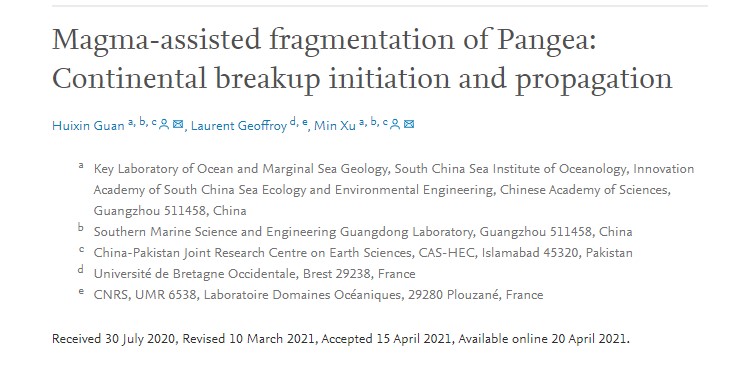
Magmatism During the Breakup of Pangaea Supercontinent
Publisher: CPJRC
time: 2021-05-25
Researcher Xu Min of CPJRC Research Theme I and Professor Laurent Geoffroy from the University of Western Brittany, France, have made new progress in the research of magmatism during the breakup of the Pangaea supercontinent, with relevant findings published in Gondwana Research.
There are usually two types of passive margins occurring during continental breakup: volcanic passive margins formed due to significant mantle melting, and non-volcanic passive margins related to insignificant or no syn-rift magmatism. The breakup of a supercontinent is usually associated with the formation of large igneous provinces. Recent studies suggest that continental breakup begins before the formation of large igneous provinces, and the magma material from the mantle plume gathers beneath the pre-thinned continental lithosphere and triggers the breakup of supercontinents.
The researchers reviewed the relevant geophysical data of six large igneous provinces formed during the breakup of Pangaea supercontinent, and found out that the direction of the central axis of the extension of continental rift formed before the magmatic eruption is not parallel to the direction of the central axis of the extension during continental breakup, and may even produce an angle of 90 degrees. Moreover, the interval between the two rifting periods can be as long as 60-90 million years, which is enough to bring the continental lithosphere back to a state of thermal equilibrium, which means that the two rifting periods are related with different periods and discontinuous tectonic processes.
The researchers also found that in the process of supercontinent breakup, ocean basins will first form between conjugate volcanic passive margins, and then expand to non-volcanic passive margins with the propagation (Fig. 1). The upwelling of mantle material under the supercontinent lithosphere may be the main reason that triggers the active breakup of continents, and the mantle heat loss along with the upwelling magma during the propagation is the main reason for the formation of non-volcanic passive margins.
The findings revealed the origin of volcanic and non-volcanic passive margins, and proposed a new tectonic model for the breakup of supercontinent. They are also of great significance for in-depth understanding of the internal driving forces for breakup of supercontinents. Assistant Researcher Guan Huixin is the first author and corresponding author of the paper, and Researcher Xu Min is the co-corresponding author. This research was funded by the National Natural Science Foundation of China, the Special Foundation for National Science and Technology Basic Research Program of China, Major Project on Talent Introduction of the Southern Marine Science and Engineering Guangdong Laboratory (Guangzhou) and so on.
Title of Thesis: Magma-assisted fragmentation of Pangea: Continental breakup initiation and propagation. Gondwana Research, 96, 56-75.
Link: https://doi.org/10.1016/j.gr.2021.04.003

Related information